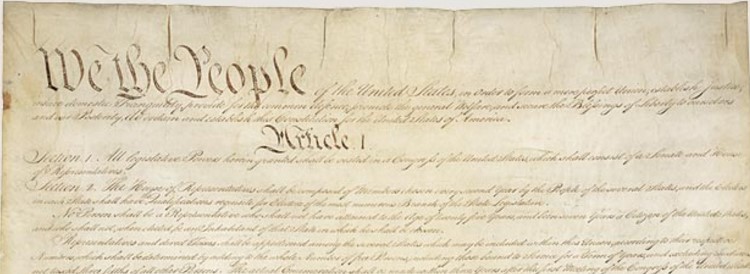In the light of recent events, and a sleepless night pondering what in the world I should be doing, my oath to support and defend the Constitution of the United States started poking at me pretty hard.
The problem came in when I realized that I don’t actually know the document all that well. It also occurred to me that I couldn’t possibly be the only person in that position, so why not read it and do the analysis publicly? Knowing the foundation of our country and how it was set up, understanding the framework for our laws cannot be a bad thing in any way, right?
As I mentioned before, I am a layman. I don’t even have a college education. Would a lawyer understand the precedent and subtleties of US Constitution better than I do? Of course she would! That’s fine. It still cannot be a bad start to look at the text as it is there, throw in a minor bit of history as I understand it and see where we go with it.
We went over the Preamble last week, but before we jump in, I want to go over how the Constitution is set up.
The US Constitution is broken down into seven Articles, each article having between one and ten sections. These sections describe what the government is set up to do, as well as loosely the process by which it will do it. After the main body of the Constitution, we also have the Amendments – thirty-three of them as of this writing. The Amendments are important. Showing a level of foresight rare for we impatient Americans, the framers of the Constitution recognized that as our country grew and changed, it was entirely possible that our needs would change as well. We have a method to change our minds. This is important. The Constitution is meant to be a dynamic document by design.
It also behooves us to think very, very carefully about what we want. We could amend the Constitution utterly to destroy the Republic. It’d be legal, and Yours Truly would be bound by her oath to go along with it. Make no mistake, this is a double-edged sword. We need to use it wisely. (Though keep in mind, we who have taken that oath? A movement to destroy the Republic might be interpreted as a domestic enemy, just sayin’.)
With that said, our next step is going to be really simple, and even easier to understand than that Preamble we discussed last week:
Article I
Section 1.
All legislative Powers herein granted shall be vested in a Congress of the United States, which shall consist of a Senate and House of Representatives.
There you have it. The power to make a law (legislative comes from the Latin word “legis,” meaning “law.”) of the United States of America is given to Congress. Congress has two sections – a Senate and a House of Representatives.
I’m not going to get into serious interpretation and interaction here yet because yes, there is a whole can o’ worms involving orders and decisions given by other branches of government. We’ll get to that as we go through this series, but I am building step by step and keeping it simple section by section. The whole point of this series is to show what is written down as the text of the Constitution. Yes, it’s simplistic. I also think that you do not come to understand anything deeply until you understand it at its most simplistic level.
Next week we will be talking about Article 1, Section 2 – This talks about qualifications for legislative office and discusses how we decide on numbers of representatives and several other things. This section is much longer and more complex.

